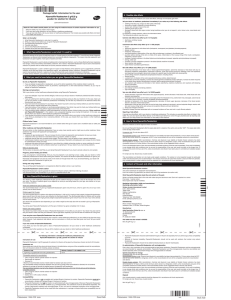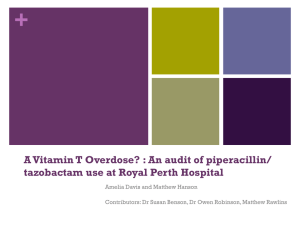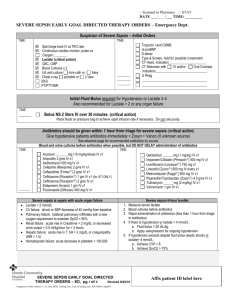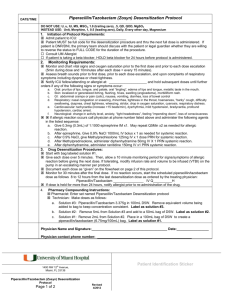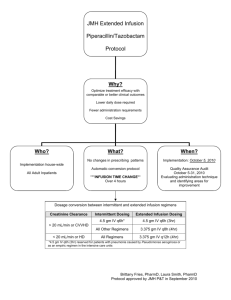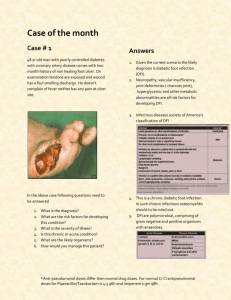Piperacillin_Tazobactam Stravencon powder for solution for infusion
advertisement
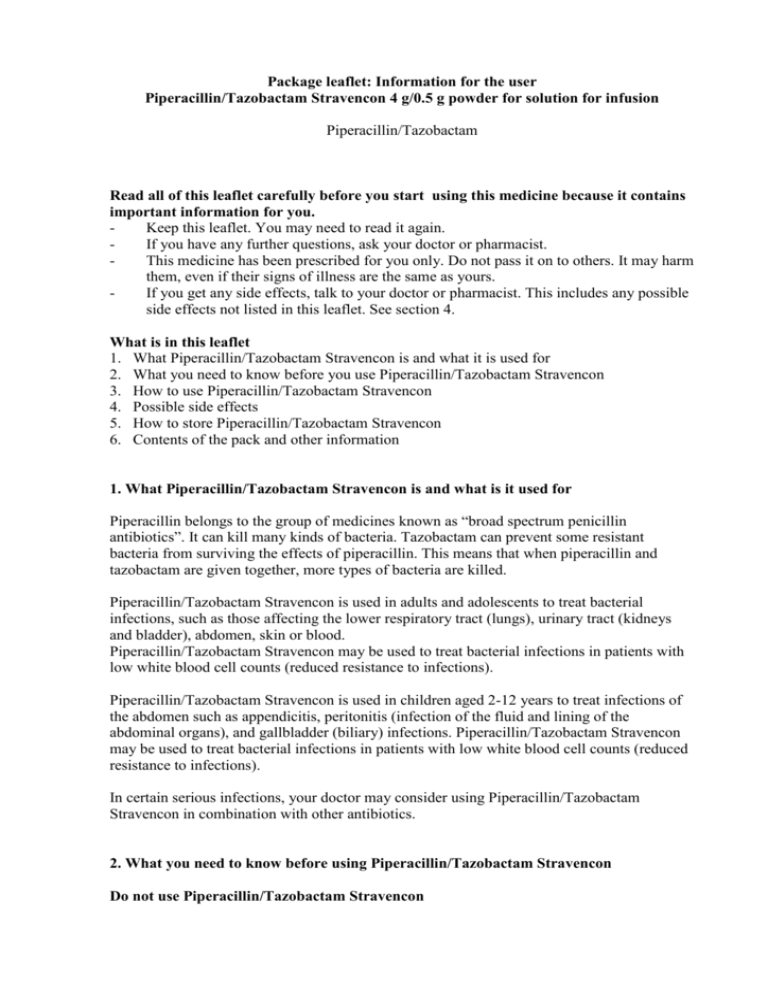
Package leaflet: Information for the user Piperacillin/Tazobactam Stravencon 4 g/0.5 g powder for solution for infusion Piperacillin/Tazobactam Read all of this leaflet carefully before you start using this medicine because it contains important information for you. Keep this leaflet. You may need to read it again. If you have any further questions, ask your doctor or pharmacist. This medicine has been prescribed for you only. Do not pass it on to others. It may harm them, even if their signs of illness are the same as yours. If you get any side effects, talk to your doctor or pharmacist. This includes any possible side effects not listed in this leaflet. See section 4. What is in this leaflet 1. What Piperacillin/Tazobactam Stravencon is and what it is used for 2. What you need to know before you use Piperacillin/Tazobactam Stravencon 3. How to use Piperacillin/Tazobactam Stravencon 4. Possible side effects 5. How to store Piperacillin/Tazobactam Stravencon 6. Contents of the pack and other information 1. What Piperacillin/Tazobactam Stravencon is and what is it used for Piperacillin belongs to the group of medicines known as “broad spectrum penicillin antibiotics”. It can kill many kinds of bacteria. Tazobactam can prevent some resistant bacteria from surviving the effects of piperacillin. This means that when piperacillin and tazobactam are given together, more types of bacteria are killed. Piperacillin/Tazobactam Stravencon is used in adults and adolescents to treat bacterial infections, such as those affecting the lower respiratory tract (lungs), urinary tract (kidneys and bladder), abdomen, skin or blood. Piperacillin/Tazobactam Stravencon may be used to treat bacterial infections in patients with low white blood cell counts (reduced resistance to infections). Piperacillin/Tazobactam Stravencon is used in children aged 2-12 years to treat infections of the abdomen such as appendicitis, peritonitis (infection of the fluid and lining of the abdominal organs), and gallbladder (biliary) infections. Piperacillin/Tazobactam Stravencon may be used to treat bacterial infections in patients with low white blood cell counts (reduced resistance to infections). In certain serious infections, your doctor may consider using Piperacillin/Tazobactam Stravencon in combination with other antibiotics. 2. What you need to know before using Piperacillin/Tazobactam Stravencon Do not use Piperacillin/Tazobactam Stravencon - if you are allergic to piperacillin or tazobactam. - if you are allergic to antibiotics known as penicillins, cephalosporins, or other betalactamase inhibitors, as you may be allergic to Piperacillin/Tazobactam Stravencon. Warnings and precautions Talk to your doctor or pharmacist before using Piperacillin/Tazobactam Stravencon: - if you have allergies. If you have several allergies, make sure you tell your doctor or other healthcare professional before receiving this medicine. - if you are suffering from diarrhoea before, or if you develop diarrhoea during or after your treatment. In this case, make sure you tell your doctor or other healthcare professional immediately. Do not take any medicine for the diarrhoea without first checking with your doctor. - if you have low levels of potassium in your blood. Your doctor may want to check your kidneys before you take this medicine and may perform regular blood tests during treatment. - if you have kidney or liver problems, or are receiving haemodialysis. Your doctor may want to check your kidneys before you are given this medicine, and may perform regular blood tests during treatment. - if you are taking certain medicines (called anticoagulants) to avoid an excess of blood clotting (see also ‘Other medicines and Piperacillin/Tazobactam Stravencon’ in this leaflet) or any unexpected bleeding occurs during the treatment. In this case, talk to your doctor or other healthcare professional immediately. - if you develop convulsions during the treatment. In this case, you should inform your doctor or other healthcare professional. - if you think you developed a new or worsening infection. In this case, you should inform your doctor or other healthcare professional. Children younger than 2 years Piperacillin/Tazobactam Stravencon is not recommended for use in children younger than 2 years due to insufficient data on safety and effectiveness. Other medicines and Piperacillin/Tazobactam Stravencon Tell your doctor or other healthcare professional if you are taking, have recently taken or might take any other medicines, including medicines obtained without a prescription. Some medicines may interact with piperacillin and tazobactam. In particular, tell your doctor or healthcare professional if you are taking any of the following medicines: - medicines for gout (probenecid). This can increase the time it takes for piperacillin and tazobactam to leave your body. - medicines to thin your blood or to treat blood clots (for example heparin, warfarin or aspirin). - medicines used to relax your muscles during surgery. Tell your doctor if you are going to have a general anaesthetic. - methotrexate (medicine used to treat cancer, arthritis or psoriasis). Piperacillin and tazobactam can increase the time it takes for methotrexate to leave your body. - medicines that reduce the level of potassium in your blood (for example tablets enhancing urination, or some medicines for cancer). - medicines containing the other antibiotics tobramycin or gentamycin. Tell your doctor if you have kidney problems. Effect on laboratory tests Tell your doctor or laboratory staff that you are taking Piperacillin/Tazobactam Stravencon if you have to provide a blood or urine sample. Pregnancy and breast-feeding If you are pregnant, or breast-feeding, think you may be pregnant or are planning to have a baby, ask your doctor or other healthcare professional before receiving this medicine. Your doctor will decide if Piperacillin/Tazobactam Stravencon is right for you. Piperacillin and tazobactam can pass to a baby in the womb or through breast milk. If you are breast-feeding, your doctor will decide if Piperacillin/Tazobactam Stravencon is right for you. Driving and using machines The use of Piperacillin/Tazobactam Stravencon is not expected to affect the ability to drive or use machines. Piperacillin/Tazobactam Stravencon contains sodium This medicine contains contains 9.4 mmol (216 mg) of sodium. This should be taken into consideration, if you are on a controlled sodium (salt) diet. 3. How to use Piperacillin/Tazobactam Stravencon Your doctor or other healthcare professional will give you this medicine through an infusion (a drip for 30 minutes) into one of your veins. The dose of medicine given to you depends on what you are being treated for, your age, and whether or not you have kidney problems. Use in adults and adolescents aged 12 years or older The usual dose is 4 g/ 0.5 g piperacillin/ tazobactam given every 6-8 hours, which is given into one of your veins (directly into the blood stream). Use in children aged 2 to 12 years The usual dose for children with abdominal infections is 100 mg/ 12.5 mg/ kg of body weight of piperacillin/ tazobactam given every 8 hours into one of your child’s veins (directly into the blood stream). The usual dose for children with low white blood cell counts is 80 mg/ 10 mg / kg of body weight of piperacillin/ tazobactam given every 6 hours into one of your child’s veins (directly into the blood stream). Your doctor will calculate the dose depending on your child´s weight but the daily dose will not exceed 4 g/ 0,5 g of Piperacillin/Tazobactam Stravencon. You will be given Piperacillin/Tazobactam Stravencon until the sign of infection has gone completely (5 to 14 days). Patients with kidney problems Your doctor may need to reduce the dose of Piperacillin/Tazobactam Stravencon or how often you are given it. Your doctor may also want to test your blood to make sure that your treatment is at the right dose, especially if you have to take this medicine for a long time. If you receive more Piperacillin/Tazobactam Stravencon than you should As you will receive Piperacillin/Tazobactam Stravencon from a doctor or other healthcare professional, you are unlikely to be given the wrong dose. However, if you experience side effects, such as convulsions, or think you have been given too much, tell your doctor immediately. If you miss a dose of Piperacillin/Tazobactam Stravencon If you think you have not been given a dose of Piperacillin/Tazobactam Stravencon, tell your doctor or other healthcare professionals immediately. If you have any further questions on the use of this medicine, ask your doctor or other healthcare professional. 4. Possible side effects Like all medicines, this medicine can cause side effects, although not everybody gets them. The serious side effects of Piperacillin/Tazobactam Stravencon are: -Serious skin rashes (Stevens-Johnson syndrome, toxic epidermal necrolysis) appearing initially as reddish target-like spots or circular patches often with central blisters on the trunk. Additional signs include ulcers in the mouth, throat, nose, extremities, genitals and conjunctivitis (red and swollen eyes). The rash may progress to widespread blistering or peeling of the skin and potentially may be life threatening. -swelling of the face, lips, tongue or other parts of the body; -shortness of breath, wheezing or trouble breathing; -severe rash, itching or hives on the skin; -yellowing of the eyes or skin; -damage to blood cells (the signs include: being breathless when you do not expect is, red or brown urine, nosebleeds and bruising). -severe or persistent diarrhoea accompanied by a fever or weakness -unexpected bleeding, particularly if you are taking anticoagulants such as warfarin. If you notice any of the above, see a doctor straight away. For frequency of these reactions, refer to the information below. Common: may affect up to 1 in 10 people diarrhoea, vomiting, nausea skin rashes Uncommon: may affect up to 1 in 100 people thrush (abnormal) decrease in white blood cells (leukopenia, neutropenia) and platelets (thrombocytopenia) allergic reaction headache, sleeplessness low blood pressure, inflammation of the veins (felt as tenderness or redness in the affected area) jaundice (yellow staining of the skin or whites of the eyes), inflammation of the mucous lining of the mouth, constipation, indigestion, stomach upset - increase of certain enzymes in the blood (alanine aminotransferase increased, aspartate aminotransferase increased) itching, nettle rash increase of muscle metabolism product in the blood (blood creatinine increased) fever, injection site reaction yeast infection (candida superinfection) Rare: may affect up to 1 in 1,000 people: - (abnormal) decrease of red blood cells or blood pigment / haemoglobin, (abnormal) decrease of red blood cells due to premature breakdown (degradation) (haemolytic anaemia), small spot bruising (purpura), bleeding of the nose (epistaxis) and bleeding time prolonged, (abnormal) increase of a specific type of white blood cells (eosinophilia) severe allergic reaction (anaphylactic/ anaphylactoid reaction, including shock) flushed red skin a certain form of infection of the colon (pseudomembranous colitis), abdominal pain inflammation of the liver (hepatitis), increase of a blood pigments breakdown product (bilirubin), increase of certain enzymes in the blood (blood alkaline phosphatase increased, gamma-glutamyltransferase increased) skin reactions with redness and formation of skin lesions (exanthema, erythema multiforme), skin reactions with blistering (bullous dermatitis) joint and muscle pain poor kidney functions and kidney problems rigors chill/ rigidity Very rare: may affect up to 1 in 10,000 people - severe decrease of granular white blood cells (agranulocytosis), severe decrease of red blood cells, white blood cells and platelets (pancytopenia) - prolonged time for blood clot formation (prolonged partial thromboplastin time, prothrombin time prolonged), abnormal lab test (positive direct Coombs), increase of platelets (thrombocythaemia) - decrease of potassium in the blood (hypokalaemia), decrease of blood sugar (glucose), decrease of the blood protein albumin, decrease of blood total protein - detachment of the top layer of the skin all over the body (toxic epidermal necrolysis), serious bodywide allergic reaction with skin and mucous lining rashes and various skin eruptions (Stevens-Johnson Syndrome) - blood urea nitrogen increased Piperacillin therapy has been associated with an increased incidence of fever and rash in cystic fibrosis patients. If you get any side effects, talk to your doctor or healthcare professional. This includes any possible side effects not listed in this leaflet. Reporting of side effects If you get any side effects, talk to your doctor. This includes any possible side effects not listed in this leaflet. You can also report side effects directly via the national reporting system listed in <to be completed in National Phase>. By reporting side effects you can help provide more information on the safety of this medicine. 5. How to store Piperacillin/Tazobactam Stravencon Keep this medicine out of the sight and reach of children. Do not use this medicine after the expiry date which is stated on the carton and the vial after “EXP“. The expiry date refers to the last day of that month. Unopened vials: Store in the original package in order to protect from light. For single use only. Discard any unused solution. Do not throw away any medicines via wastewater or household waste. Ask your pharmacist how to throw away medicines you no longer use. These measures will help protect the environment. 6. Content of the pack and other information What Piperacillin/Tazobactam Stravencon contains The active substances are piperacillin and tazobactam. Each vial contains piperacillin sodium equivalent to 4 g piperacillin and 0.5 g tazobactam sodium equivalent to 0.5 g tazobactam. There are no other ingredients. What Piperacillin/Tazobactam Stravencon looks like and contents of the pack Powder for solution for infusion Piperacillin/Tazobactam Stravencon 4 g/ 0,5 g is a white to off-white powder supplied in packs of 1 or 10 vials enclosed in a carton with a package leaflet. Not all pack sizes may be marketed. Marketing Authorisation Holder and Manufacturer Stravencon Limited, Landmark House 17 Hanover Square London W1S 1HU United Kingdom Manufacturer IPG Pharma Limited Atrium Court The Ring Bracknell RG12 1BW United Kingdom This leaflet was last revised in 28 May 2015 This medicinal product is authorized in the Member States of the EEA under the following names ----------------------------------------------------------------------------------------------------------------The following information is intended for medical or healthcare professionals only: Piperacillin/Tazobactam Stravencon 4 g/ 0.5 g Instructions for use Piperacillin/Tazobactam Stravencon will be given by intravenous infusion (a drip for 30 minutes). The solution should be prepared under aseptic conditions. The solution is inspected visually to check for the presence of particles or discoloration. The solution may be used only when it is clear and free of particles. Intravenous use Reconstitute each vial with the volume of solvent shown in the table below, using one of the compatible solvents for reconstitution. Swirl until dissolved (for details on handling, please see below). Content of vial 4 g/ 0.50 g (4 g piperacillin and 0.5 g tazobactam) Volume of solvent* to be added to vial 20 ml *Compatible solvents for reconstitution: - 0.9% (9 mg/ml) sodium chloride solution for injection Sterile water for injection. The maximum recommended volume of sterile water for injection per dose is 50 ml. Glucose 5% (50 mg/ml) in water The reconstituted solutions should be withdrawn from the vial by syringe. When reconstituted as directed, the vial contents withdrawn by syringe will provide the labelled amount of piperacillin and tazobactam. The reconstituted solutions may be further diluted to the desired volume (for example 50 ml to 100 ml) with one of the following compatible solvents: 0.9% (9 mg/ml) sodium chloride solution for injection Glucose 5% (50 mg/ml) in water Dextran 6% (60 mg/ml) in 0.9% (9 mg/ml) sodium chloride solution. After reconstitution, or reconstitution and further dilution, chemical and physical in-use stability has been demonstrated for up to 48 hours when stored in a refrigerator at 2-8°C, when reconstituted with one of the compatible solvents for reconstitution or when using one of the compatible solvents for further dilution of the reconstituted solution. From a microbiological point of view, the reconstituted and diluted solutions should be used immediately. If not used immediately, in-use storage times and conditions prior to use are the responsibility of the user and would normally not be longer than 12 hours at 2-8°C, unless reconstitution and dilution have taken place in controlled and validated aseptic conditions. Incompatibilities Whenever Piperacillin/Tazobactam Stravencon is used concurrently with another antibiotic (for example aminoglycosides), the substances must be administered separately. The mixing of beta-lactam antibiotics with aminoglycosides, in vitro, can result in substantial inactivation of the aminoglycosides. Piperacillin/Tazobactam Stravencon should not be mixed with other substances in a syringe or infusion bottle since compatibility has not been established. Because of chemical instability, Piperacillin/Tazobactam Stravencon should not be used with solutions containing sodium bicarbonate. Lactated Ringer’s (Hartmann´s) solution is not compatible with piperacillin/tazobactam. Piperacillin/Tazobactam Stravencon should not be added to blood products or albumin hydrolysates. Piperacillin/Tazobactam Stravencon should be administered through an infusion set separately from any other drugs unless compatibility is proven.
